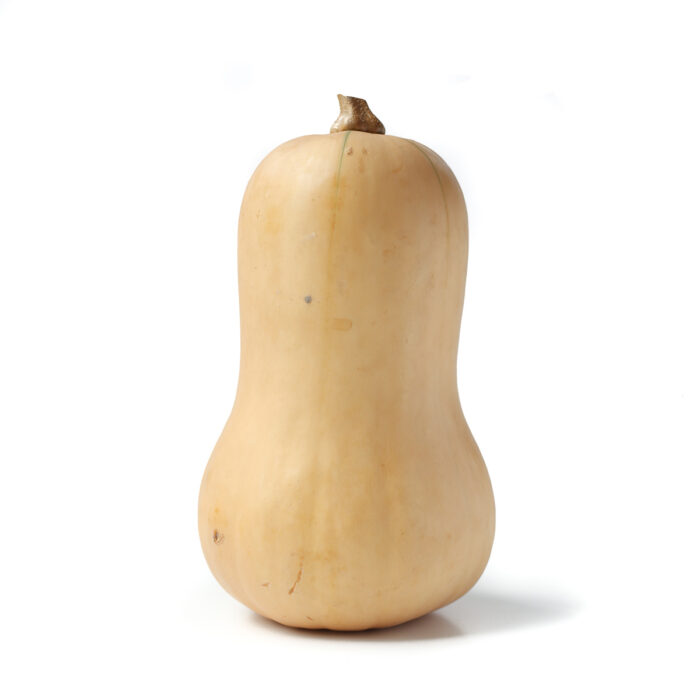Butternut squash is versatile, delicious, and one of the most popular winter squashes out there.
Taste: On the sweet side, with a bit of a nutty taste and a texture smooth like – yep, you guessed it – butter.
Favorite Preparations: Roasting in cubes brings out butternut squash’s natural sweetness; butternut squash is also velvety perfection pureed in a soup or made into a creamy pasta sauce.

About Butternut Squash
Butternut squash is a medium-sized squash; tall with a round bottom that houses its seeds. Its hue is a unique, subtle yellow-tan, but inside, butternut squash is a bright, vibrant orange. The interior is extremely versatile, lending itself especially well to roasting or pureeing into smooth and velvety soups.
While you could eat the skin if you really wanted to, most peel it off or scoop out the squash and discard the skin. It’s thick, tough, and just not ideal for eating.
The seeds reside inside the larger, bottom portion of the squash. And they’re edible! Butternut squash seeds are more petite in size than pumpkin seeds, but still excellent roasted.

Butternut Squash Scientific Name
Cucurbita moschata (pronounced koo_KER-bih-ta MOSS-kah-ta) is butternut squash’s scientific name. It is a member of the Cucurbitaceae family (also known as Cucurbits or the gourd family).
Butternut Squash Nutrition & Benefits
It’s loaded with nutrients, including vitamins A and C, along with beta carotene. It’s also an excellent source of B vitamins, potassium, and magnesium.
Like most squashes, it’s also low in calories and an excellent source of fiber.

How to Select Butternut Squash
You want a squash that is heavy for its size, with few blemishes, a firmly intact stem, and no soft spots or visible wrinkles.

How to Peel & Cut Butternut Squash
Do I Have to Peel Butternut Squash?
It depends. Butternut squash has a thick, unpalatable rind. If you’re cooking it in halves, you can leave the skin on – but you definitely don’t want to eat it. Otherwise, you’ll want to create a flat base on your squash so that it doesn’t rock on your cutting board, then peel off the skin with a vegetable peeler.
Preparing Halves for Baking or Roasting
There are times when you just want to roast the halves of your butternut squash, and those are glorious times – because all you need to do is:
- Wash and dry your squash.
- Cut off the top and bottom.
- Place the bottom, flat-cut end on your cutting board, making sure it’s nice and stable.
- With a heavy, sharp knife, cut the squash in half vertically.
- Scoop out the seeds.

How to Cut Up Butternut Squash into Pieces
Cutting your squash into cubes or other shapes? You’ve got a bit more work to do. But don’t stress! It’s totally doable. Here’s how:
- Wash and dry your squash.
- Lop off the top and the bottom of the squash. This helps to stabilize the squash while you’re working with it.
- Peel off the skin using a vegetable peeler. I like to do this over my cutting board in case my squash slips out of my hand (as opposed to over the sink). Peel vertically from end to end, starting with the long end then flip it over to get the round end.
- Place bottom-side-down on your cutting board and with a sharp, heavy knife, cut the squash in half. You will want to press on the back of the knife with the heel of your other hand, slowly rocking and pressing the knife through the squash until it is cut in two.
- Scoop the seeds out. You can use a spoon or I love to use an ice cream scoop or cookie scoop – makes it so easy!
- Place one side flat side down on the board (again with the stabilization!) Cut the squash in half going the other direction, so that the narrow end is one piece and the bulbous end is one piece.
- Cut each piece into strips, then cut those sticks into cubes (or whatever shape you want it to be).
How to Cook Butternut Squash
There are so many ways to cook and enjoy butternut squash, from cutting in half and then roasting and pureeing for soups and pies to roasting chunks for salads or snacking … to steaming, microwaving, and more!
Read this comprehensive post about how to cook butternut squash for detailed information about those methods and more.
Favorite Butternut Squash Recipes
All butternut squash recipes on Good Gourds can be found here, but here are my very favorites:
- Easy Butternut Squash Soup with Coconut Milk
- Roasted Butternut Squash Soup with Apples
- Vegan Welsh Rarebit with Butternut Squash “Cheese” Sauce
Can You Freeze Butternut Squash?
Yes! Place cubed raw butternut squash in freezer bags, label, and freeze for up to 3 months. Remove from freezer and cook as desired. Or you can freeze cooked butternut squash too!

Can Dogs Eat Butternut Squash?
Yes! According to the ASPCA, butternut squash is non-toxic to dogs and cats. And squash, in moderation of course, is actually good for them! This is a frequently-searched question, so I thought I would include it here!


